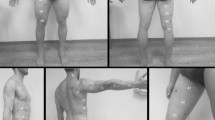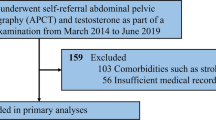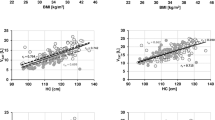Abstract
OBJECTIVE: We studied the validity and reproducibility of a new abdominal ultrasound protocol for the assessment of intra-abdominal adipose tissue.
MEASUREMENTS: Intra-abdominal adipose tissue was assessed by CT, MRI, anthropometry and ultrasonography on a single day. By ultrasonography the distance between peritoneum and lumbar spine was measured using a strict protocol, including the location of the measurements, pressure on the transducer and respiration. All measurements were repeated after 3 months.
RESULTS: The study population consisted of 19 overweight patients with a body mass index (BMI) of 32.9 kg/m2 (s.d. 3.7), intra-abdominal adipose tissue on CT 140.1 cm2 (s.d. 55.9), and a mean ultrasound distance of 9.8 cm (s.d. 2.5). There was a strong association between the CT and ultrasonographic measures: Pearson correlation coefficient was 0.81 (P<0.001). The correlation between ultrasound and waist circumference was 0.74 (P<0.001), the correlation between CT and waist circumference was 0.57 (P=0.01). Ultrasound appeared a good method to diagnose intra-abdominal obesity: the area under the ROC curve was 0.98. During the follow-up period of 3 months, the patients lost on average almost 3 kg of body weight. The correlation coefficient between changes in intra-abdominal adipose tissue assessed by CT and ultrasound was 0.74 (P<0.001). The correlation coefficient of the mean ultrasound distance assessed by two different sonographers at baseline was 0.94 (P<0.001), the mean difference 0.4 cm (s.d. 0.9), and the coefficient of variation 5.4%, indicating good reproducibility of the ultrasound measurements.
CONCLUSIONS: The results of this validation study show that abdominal ultrasound, using a strict protocol, is a reliable and reproducible method to assess the amount of intra-abdominal adipose tissue and to diagnose intra-abdominal obesity.
This is a preview of subscription content, access via your institution
Access options
Subscribe to this journal
Receive 12 print issues and online access
$259.00 per year
only $21.58 per issue
Buy this article
- Purchase on Springer Link
- Instant access to full article PDF
Prices may be subject to local taxes which are calculated during checkout




Similar content being viewed by others
References
Calle EE, Thun MJ, Petrelli JM, Rodriguez C, Heath CWJ . Body-mass index and mortality in a prospective cohort of U.S. adults New Engl J Med 1999 341: 1097–1105.
Hubert HB, Feinleib M, McNamara PM, Castelli WP . Obesity as an independent risk factor for cardiovascular disease: a 26-year follow-up of participants in the Framingham Heart Study Circulation 1983 67: 968–977.
Vague J . The degree of masculine differentiation of obesities: a factor determining predisposition to diabetes, atherosclerosis, gout and uric calculous disease Am J Clin Nutr 1956 4: 20–34.
Després JP . Abdominal obesity as important component of insulin-resistance syndrome Nutrition 1993 9: 452–459.
Reaven GM . Banting lecture 1988. Role of insulin resistance in human disease Diabetes 1988 37: 1595–1607.
Laakso M . The possible pathophysiology of insulin resistance syndrome Cardiovascular Risk Factors 1993 3: 55–66.
Alberti KG, Zimmet PZ . Definition, diagnosis and classification of diabetes mellitus and its complications. Part 1: diagnosis and classification of diabetes mellitus provisional report of a WHO consultation Diabetic Med 1998 15: 539–553.
Seidell JC, Bakker CJ, van der Kooy K . Imaging techniques for measuring adipose-tissue distribution—a comparison between computed tomography and 1.5-T magnetic resonance Am J Clin Nutr 1990 51: 953–957.
van der Kooy K, Leenen R, Deurenberg P, Seidell JC, Westerterp KR, Hautvast JG . Changes in fat-free mass in obese subjects after weight loss: a comparison of body composition measures Int J Obes Relat Metab Disord 1992 16: 675–683.
Armellini F, Zamboni M, Robbi R et al. Total and intra-abdominal fat measurements by ultrasound and computerized tomography Int J Obes Relat Metab Disord 1993 17: 209–214.
Bellisari A, Roche AF, Siervogel RM . Reliability of B-mode ultrasonic measurements of subcutaneous adipose tissue and intra-abdominal depth: comparisons with skinfold thicknesses Int J Obes Relat Metab Disord 1993 17: 475–480.
Tornaghi G, Raiteri R, Pozzato C et al. Anthropometric or ultrasonic measurements in assessment of visceral fat? A comparative study Int J Obes Relat Metab Disord 1994 18: 771–775.
Armellini F, Zamboni M, Rigo L, Todesco T, Bergamo-Andreis IA, Procacci C, Bosello O . The contribution of sonography to the measurement of intra-abdominal fat J Clin Ultrasound 1990 18: 563–567.
Armellini F, Zamboni M, Rigo L, Bergamo-Andreis IA, Robbi R, De Marchi M, Bosello O . Sonography detection of small intra-abdominal fat variations Int J Obes 1991 15: 847–852.
van der Kooy K, Seidell JC . Techniques for the measurement of visceral fat: a practical guide Int J Obes Relat Metab Disord 1993 17: 187–196.
Acknowledgements
We thank the ultrasound technician G Boonen for his valuable contribution and Professor WPThM Mali for his support.
Author information
Authors and Affiliations
Corresponding author
Rights and permissions
About this article
Cite this article
Stolk, R., Wink, O., Zelissen, P. et al. Validity and reproducibility of ultrasonography for the measurement of intra-abdominal adipose tissue. Int J Obes 25, 1346–1351 (2001). https://doi.org/10.1038/sj.ijo.0801734
Received:
Revised:
Accepted:
Published:
Issue Date:
DOI: https://doi.org/10.1038/sj.ijo.0801734
Keywords
This article is cited by
-
Revisiting the predictability of follicular fluid leptin and related adiposity measures for live birth in women scheduled for ICSI cycles: a prospective cohort study
Middle East Fertility Society Journal (2024)
-
Combined maternal central adiposity measures in relation to infant birth size
Scientific Reports (2024)
-
Adherence to the Mediterranean diet as a possible additional tool to be used for screening the metabolically unhealthy obesity (MUO) phenotype
Journal of Translational Medicine (2023)
-
Evaluation of progression in metabolic parameters along with markers of subclinical inflammation and atherosclerosis among normoglycemic first degree relatives of type 2 diabetes mellitus patients
International Journal of Diabetes in Developing Countries (2023)
-
Maternal Blood-Based Protein Biomarkers in Relation to Abdominal Fat Distribution Measured by Ultrasound in Early Mid-Pregnancy
Reproductive Sciences (2022)



